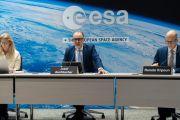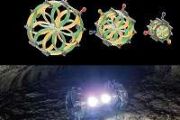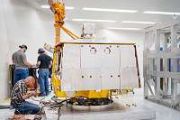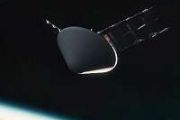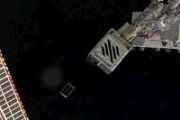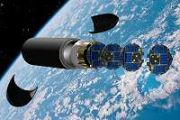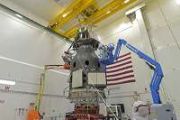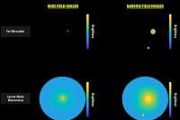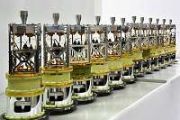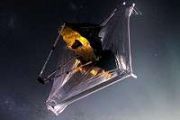
Copernical Team
Exoplanets face challenges from intense space weather
 New research from NASA's Chandra X-ray Observatory and ESA's XMM-Newton highlights the harsh space weather that planets around other stars may face. The study focused on the impact of X-rays on potential planets orbiting red dwarf stars, which are the most common type of star in the universe.
The findings suggest that only planets with atmospheres rich in greenhouse gases, such as carbon d
New research from NASA's Chandra X-ray Observatory and ESA's XMM-Newton highlights the harsh space weather that planets around other stars may face. The study focused on the impact of X-rays on potential planets orbiting red dwarf stars, which are the most common type of star in the universe.
The findings suggest that only planets with atmospheres rich in greenhouse gases, such as carbon d The Moon a remnant of Earth's mantle
 A collaborative study by researchers from the University of Gottingen and the Max Planck Institute for Solar System Research (MPS) has offered new insights into the formation of the Moon and the origins of Earth's water. The findings challenge long-standing assumptions about the Moon's origin and propose that it may have formed primarily from material ejected from Earth's mantle, with minimal co
A collaborative study by researchers from the University of Gottingen and the Max Planck Institute for Solar System Research (MPS) has offered new insights into the formation of the Moon and the origins of Earth's water. The findings challenge long-standing assumptions about the Moon's origin and propose that it may have formed primarily from material ejected from Earth's mantle, with minimal co Asteroid impact sulfur release less lethal in dinosaur extinction
 Approximately 66 million years ago, a massive asteroid known as the Chicxulub impactor struck the Yucatan Peninsula in present-day Mexico. Measuring an estimated 10 to 15 kilometers in diameter, the asteroid left a colossal 200-kilometer-wide crater. This event triggered rapid climate changes that ultimately caused the extinction of non-avian dinosaurs and about 75% of Earth's species. A signifi
Approximately 66 million years ago, a massive asteroid known as the Chicxulub impactor struck the Yucatan Peninsula in present-day Mexico. Measuring an estimated 10 to 15 kilometers in diameter, the asteroid left a colossal 200-kilometer-wide crater. This event triggered rapid climate changes that ultimately caused the extinction of non-avian dinosaurs and about 75% of Earth's species. A signifi NASA scientists find new human-caused shifts in global water cycle
 In a recently published paper, NASA scientists use nearly 20 years of observations to show that the global water cycle is shifting in unprecedented ways. The majority of those shifts are driven by activities such as agriculture and could have impacts on ecosystems and water management, especially in certain regions.
"We established with data assimilation that human intervention in the glob
In a recently published paper, NASA scientists use nearly 20 years of observations to show that the global water cycle is shifting in unprecedented ways. The majority of those shifts are driven by activities such as agriculture and could have impacts on ecosystems and water management, especially in certain regions.
"We established with data assimilation that human intervention in the glob Pakistani satellite joins two others in successful launch
 China's Long March 2D carrier rocket successfully deployed three satellites into their designated orbits during a launch on Friday afternoon. The mission, conducted at 12:07 pm from the Jiuquan Satellite Launch Center in the Inner Mongolia autonomous region, included the deployment of the Tianlu 1, PRSC-EO1, and Lantan 1 satellites, according to China Aerospace Science and Technology Corp, the r
China's Long March 2D carrier rocket successfully deployed three satellites into their designated orbits during a launch on Friday afternoon. The mission, conducted at 12:07 pm from the Jiuquan Satellite Launch Center in the Inner Mongolia autonomous region, included the deployment of the Tianlu 1, PRSC-EO1, and Lantan 1 satellites, according to China Aerospace Science and Technology Corp, the r SpaceX set to launch Hisdesat's SpainSat NG I satellite on January 28
 The SpainSat NG I secure communications satellite, owned by the Spanish governmental operator Hisdesat, is scheduled to launch on January 28. SpaceX, the U.S.-based aerospace company, will carry out the mission, utilizing its Falcon 9 rocket to place the satellite into orbit from Cape Canaveral, Florida.
The launch is slated for the evening of January 28 in the United States, which corresp
The SpainSat NG I secure communications satellite, owned by the Spanish governmental operator Hisdesat, is scheduled to launch on January 28. SpaceX, the U.S.-based aerospace company, will carry out the mission, utilizing its Falcon 9 rocket to place the satellite into orbit from Cape Canaveral, Florida.
The launch is slated for the evening of January 28 in the United States, which corresp Professor's Classroom Is Where Critical Thinking Meets Space Policy
 Cadets from different academic disciplines credit U.S. Air Force Academy Department of Political Science Professor Madison Walker with stoking their passion for space law, policy and research.
Cadet 1st Class Anjulina Abdon, a Political Science major, worked with the space policy professor on her space deterrence theory capstone project during the fall. Abdon will attend U.S. Air Force rem
Cadets from different academic disciplines credit U.S. Air Force Academy Department of Political Science Professor Madison Walker with stoking their passion for space law, policy and research.
Cadet 1st Class Anjulina Abdon, a Political Science major, worked with the space policy professor on her space deterrence theory capstone project during the fall. Abdon will attend U.S. Air Force rem Peak Performance in Microgravity
 At the start of a new year, many people think about making positive changes in their lives, such as improving physical fitness or learning a particular skill. Astronauts on the International Space Station work all year to maintain a high level of performance while adapting to changes in their physical fitness, cognitive ability, sensory perception, and other functions during spaceflight.
R
At the start of a new year, many people think about making positive changes in their lives, such as improving physical fitness or learning a particular skill. Astronauts on the International Space Station work all year to maintain a high level of performance while adapting to changes in their physical fitness, cognitive ability, sensory perception, and other functions during spaceflight.
R OP-ED: John Glenn Is Back
 Some things just come full circle. In 1962, a no-nonsense test pilot with a gleaming bald head and steely determination strapped himself into a Mercury capsule and became the first American to orbit Earth. Now, 62 years later, another bald maverick with that same unwavering grit just launched a 322-foot rocket bearing Glenn's name straight into orbit - and did it on the first try.
Jeff Bez
Some things just come full circle. In 1962, a no-nonsense test pilot with a gleaming bald head and steely determination strapped himself into a Mercury capsule and became the first American to orbit Earth. Now, 62 years later, another bald maverick with that same unwavering grit just launched a 322-foot rocket bearing Glenn's name straight into orbit - and did it on the first try.
Jeff Bez Malargue antenna upgrade boosts data capacity
 The Malargue deep-space communication station in Argentina has undergone a significant upgrade, enhancing its data transmission capabilities by nearly 80%. Completed in late July 2024, this improvement is set to meet the growing demands of deep-space missions and increasing international requests.
As deep-space exploration intensifies, the need for ground stations to handle larger and more
The Malargue deep-space communication station in Argentina has undergone a significant upgrade, enhancing its data transmission capabilities by nearly 80%. Completed in late July 2024, this improvement is set to meet the growing demands of deep-space missions and increasing international requests.
As deep-space exploration intensifies, the need for ground stations to handle larger and more 



